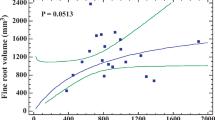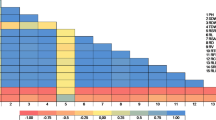Abstract
The developmental pattern of jicama (Pachyrhizus erosus (L.) Urban) was studied by sampling plants aged 20 to 36 weeks at weekly intervals. There was an increase in all characteristics of foliage: fresh and dry weight, number of leaves per plant, main stem length, number of leaves, nodes and internodes of the main stem; and in all root characteristics: fresh and dry weight, diameter and length. The chemical analysis was determined for roots at different plant ages. The range values for dry matter were 16.19–22.28%, protein 1.11–1.62%, fat 0.553–0.867%, crude fiber 0.3048–0.3943%, and ash 0.669–1.089%. The chemical constituents fluctuated with age but without specific trends. These values are considered the first record of roots produced by plants grown in Mexico.
Similar content being viewed by others
References
Clausen RT (1944) A botanical study of the yam bean (Pachyrhizus). Cornell University Agricultural Experiment Station, Memoir No. 264. New York: Cornell University, 38 pp.
Paull RE, Chen NJ, Fukuda SK (1988) Planting dates related to tuberous root yield, vine length, and quality attributes of yam bean. Hortscience 23(2): 326–329.
Isordia AA (1990) Fertilización y distancia entre plantas de jícama en el Valle de Matatipac, Nayarit. Tesis. Universidad Autónoma de Nayarit, Xalisco, Nayarit, México, pp 27–30.
Kay DE (1973) Yam bean, potato bean. In Root crops, ed. Kay Tropical Products Institute, London, pp 240–245.
Van Hoof WCH, Sorensen M (1989)Pachyrhizus erosus (L.) Urban. In Westphal E, Jansen PCM (eds), Plant resources of South-East Asia. Wageningen: Pudoc, pp 213–215.
AOAC (1984) Official methods of analysis, 14th edn. Washington, DC: Association of Official Analitical Chemists.
Cotter DJ, Gomez RE (1979) Daylength effect on root development of jicama (Pachyrhizus erosus Urban). Hortscience 14: 733–734.
Bautista ODK, Cadiz TG (1967) Sinkamas in the Philippines. In Knott JE, Deanon JR (eds), Vegetable production in the South East Asia, 366 pp.
Porterfield WM jr (1951) The principal Chinese vegetables foods and food plants of Chinatown market. Econ Bot 5: 12–13.
Purseglove JW (1968) Tropical crops, Dicotyledons 1. New York: John Wiley and Sons, pp 281–284.
Srivastava GS, Shukla DS, Awasthi DN (1973) We can grow sankalu in the plains of Uttar Pradesh. Indian Farming 23(9): 32.
Villarreal PJA (1980) El cultivo de la jicama (Pachyrhizus erosus Urban). Study Report. EAG, Universidad de Sonora, Hermosillo, Sonora, Mexico.
Author information
Authors and Affiliations
Rights and permissions
About this article
Cite this article
Fernandez, M.V., Warid, W.A., Loaiza, J.M. et al. Developmental patterns of jicama (Pachyrhizus erosus (L.) Urban) plant and the chemical constituents of roots grown in Sonora, Mexico. Plant Food Hum Nutr 50, 279–286 (1997). https://doi.org/10.1007/BF02436074
Received:
Accepted:
Issue Date:
DOI: https://doi.org/10.1007/BF02436074




